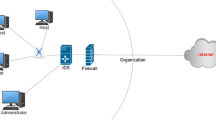Abstract
With the dramatic opening-up of network, network security becomes a severe social problem with the rapid development of network technology. Intrusion Detection System (IDS) is an innovative and proactive network security technology, which becomes a hot topic in both industry and academia in recent years. There are four main characteristics of intrusion data that affect the performance of IDS including multicomponent, data imbalance, time-varying and unknown attacks. We propose a novel IDS framework called HMLD to address these issues, which is an exquisite designed framework based on Hybrid Multi-Level Data Mining. In this paper, we use KDDCUP99 dataset to evaluate the performance of HMLD. The experimental results show that HMLD can reach 96.70% accuracy which is nearly 1% higher than the recent proposed optimal algorithm SVM+ELM+Modified K-Means. In details, HMLD greatly increased the detection accuracy of DoS attacks and R2L attacks.














Similar content being viewed by others
References
Alriyami, Q.M., Asimakopoulou, E., Bessis, N.: A survey of intrusion detection systems for mobile ad hoc networks. In: International Conference on Intelligent Networking and Collaborative Systems(INCoS), Salerno, Italy, pp. 427–432 (2014)
Denning, D.E.: An intrusion-detection model. In: IEEE Symposium on Security and Privacy, CA, USA, Oakland , pp. 222–232 (1986)
Vapnik, V., Cortes, C.: Support vector networks. Mach. Learn. 20(3), 273–297 (1995)
Zhang, G., Patuwo, B.E., Hu, M.Y.: Forecasting with artificial neural networks: the state of the art. Int. J. Forecast. 14(1), 35–62 (1998)
Quinlan, J.R.: Induction of decision trees. Mach. Learn. 1(1), 81–106 (1986)
Cutler, A., Cutler, D.R., Stevens, J.R.: Random forests. Mach. Learn. 45(1), 157–176 (2004)
Jain, A.K., Murty, M.N., Flynn, P.J.: Data clustering: a review. ACM Comput. Surv. 31(3), 264–323 (1999)
Hartigan, J.A., Wong, M.A.: A K-means clustering algorithm. Appl. Stat. 28(1), 100–108 (1979)
Khan K., Rehman, S.U., Aziz, K., Fong, S., Sarasvady, S.: DBSCAN: past, present and future. In: Fifth International Conference on the Applications of Digital Information and Web Technologies (ICADIWT), Bangalore, India, pp. 232–238 (2014)
Wang, K., Zhang, J., Li, D., Zhang, X., Guo, T.: Adaptive affinity propagation clustering. Acta Automatica Sinica 33(12), 1242–1246 (2007)
Wang, G., Hao, J., Ma, J., Huang, L.: A new approach to intrusion detection using artificial neural networks and fuzzy clustering. Expert Syst. Appl. 37(9), 6225–6232 (2010)
Gogoi, P., Bhattacharyya, D.K., Borah, B., Kalita, J.K.: MLH-IDS: a multi-level hybrid intrusion detection method. Comput. J. 57(4), 602–623 (2014)
KDD Cup 1999 Data. [Online]. http://kdd.ics.uci.edu/databases/kddcup99/kddcup99.html
Guyon, I., Elisseeff, A.: An introduction to variable and feature selection. J. Mach. Learn. Res. 3(6), 1157–1182 (2003)
Al-Yaseen, W.L., Othman, Z.A., Nazri, M.Z.A.: Multi-level hybrid support vector machine and extreme learning machine based on modified K-means for intrusion detection system. Expert Syst. Appl. 67, 296–303 (2017)
Ambusaidi, M., He, X., Nanda, P., Tan, Z.: Building an intrusion detection system using a filter-based feature selection algorithm. IEEE Trans. Comput. 65(10), 2986–2998 (2016)
Horng, S.J., Su, M.Y., Chen, Y.H., Kao, T.W., Chen, R.J., Lai, J.L., Perkasa, C.D.: A novel intrusion detection system based on hierarchical clustering and support vector machines. Expert Syst. Appl. 38(1), 306–313 (2011)
Elkan, C.: Results of the KDD’99 classifier learning. ACM SIGKDD Explor. Newslett. 1(2), 63–64 (2000)
Author information
Authors and Affiliations
Corresponding author
Rights and permissions
About this article
Cite this article
Yao, H., Wang, Q., Wang, L. et al. An Intrusion Detection Framework Based on Hybrid Multi-Level Data Mining. Int J Parallel Prog 47, 740–758 (2019). https://doi.org/10.1007/s10766-017-0537-7
Received:
Accepted:
Published:
Issue Date:
DOI: https://doi.org/10.1007/s10766-017-0537-7




